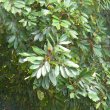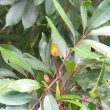Cunonia capensis
| Botanical Name | Cunonia capensis |
|||||||||||
| Family | Cunoniaceae - The Wild-alder family |
|||||||||||
| Pronunciation | koo-NO-nee-uh ka-PEN-sis |
|||||||||||
| Common Name(s) |
English: Butter-spoon Tree; Red Alder; Red Els
Afrikaans: Botterlepelboom; Botterlepeltjie; Elsehout; Roode Elseboom; Rooi-els
IsiXhosa: Igqwakra; Umqwashube
IsiZulu: Umaphethu; Umhlalane; Umlulama; Umlulamomkhulu
|
|||||||||||
| Plant Group |
|
|||||||||||
| Plant Size |
|
|||||||||||
| Position |
|
|||||||||||
| General Information |
|
|||||||||||
| Specific Information | Cunonia capensis is beautiful and versatile, evergreen specimen tree with dark green, serrated, glossy leaves and contrasting reddish leaf-stalks. The yellow and reddish growth tips are enclosed by two large stipules pressed together forming a spoon-like shape, from which it gets its common name 'Butterspoon Tree'. A relatively small tree, growing well in both sun and shade, it has a non-invasive root system and can be very fast growing. The Red Alder does not grow well in hot and dry conditions, requiring a moist, mild climate and a generous supply of water. This water-loving tree is particularly suitable for marshy, water-logged gardens, to enhance natural water features, to grace streams and dams and is a good choice for large pots on a patio where it will grow beautifully for years. Trees planted in drier areas will need frequent watering, and shelter from sun, heat, cold/hot winds and frost. The large bottlebrush-shaped flowers that appear in autumn are sweetly scented and attract insects and butterflies. The fruits are small, brown, two-horned capsules which release very fine, sticky seed. |
|||||||||||
| Ad Break | ||||||||||||
| Flowers | ||||||||||||
| Description | spikes packed densely with small flowers with long stamens forming a bottlebrush-like head |
|||||||||||
| Season |
|
|||||||||||
| Colour |
|
|||||||||||
| Growth Rate |
|
|||||||||||
| Plant Uses |
|
|||||||||||
| Distribution and Habitat | from the Western Cape to the Eastern Cape and KwaZulu-Natal, and into Mozambique, along the coast and adjacent inland areas in Afromontane forests and moist areas, especially along watercourses |
|||||||||||
| Planting Suggestions | Young plants will need plenty of water and a sheltered aspect, in rich soil with moisture holding qualities. For very fast growth a regular program of deep watering should be followed. Top dressing with compost and a thick application of mulch will do much to stimulate quick and healthy growth. Keep young plants shaded until they are well established. Cunonia capensis can be propagated from seed sown in deep seed trays and covered very lightly with finely sifted seedling mix, and from cuttings taken in early summer. The old method of digging a deep hole and filling it with soil and compost has resulted in many trees failing to thrive, dying, rotting at the base or worse still, falling over in later years due to poor root development. Refer to the following sites for the best method of planting trees: International Society of Arboriculture: New Tree Planting Tree People: Plant the right way For those of you who have a clay problem try: |
|||||||||||
| Medicinal Uses | The tree is reportedly used for treating nervous complaints. |
|||||||||||
| Ad Break | ||||||||||||







Discuss this plant
Share knowledge, ask a question or give an experience.